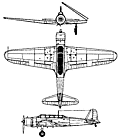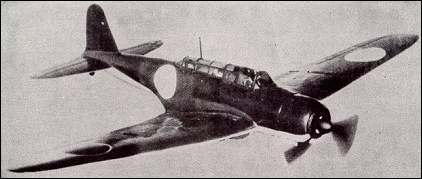|
| Designed to a 1935 requirement, and
already in service for four years when
Japan entered the war, the Nakajima
B5N was in 1941 without question the
best carrierborne torpedo-bomber in
the world. Powered by a Nakajima
Hikan radial engine, the low-wing
three-crew monoplane with inwards-retracting
wide-track landing gear
was exceptionally clean, and first flew
in January 1937. The following year
production B5N1 aircraft were
embarking in Japan's carriers and
shore-based units were deployed in
China. In 1939 the improved B5N2
appeared with a more powerful Sakae
11 engine in a smaller cowling,
although armament and bombload
were unchanged, and this version remained
in production until 1943. When
Japan attacked the USA the B5N2 had
wholly replaced the B5N1 with operational
units, and 144 B5N2s were involved
in the fateful attack on Pearl
Harbor; within the next 12 months aircraft
of this type sank the American
carriers USS Hornet, Lexington and
Yorktown. Given the reporting name
'Kate' by the Allies, the B5N certainly
earned the respect of the Americans,
and in all the major carrier battles of
the Pacific War attracted the undivided
attention of defending fighters.
With its puny defensive armament of a
single machine-gun and laden with a
large bomb or torpedo, however, the
B5N began to suffer very heavily, and
although the type was fully committed
during the Solomons campaign the
survivors were withdrawn from combat
after the Philippine battles of 1944.
Thereafter, on account of their excellent
range, they were assigned to antisubmarine
and maritime reconnaissance
duties in areas beyond the range
of Allied fighters. Production of all
B5Ns reached 1,149.

| MODEL | B5N2 |
| CREW | 3 |
| ENGINE | 1 x Nakajima NK1B "Sakae", 746kW |
| WEIGHTS |
| Take-off weight | 4100 kg | 9039 lb |
| Empty weight | 2279 kg | 5024 lb |
| DIMENSIONS |
| Wingspan | 15.52 m | 51 ft 11 in |
| Length | 10.3 m | 34 ft 10 in |
| Height | 3.7 m | 12 ft 2 in |
| Wing area | 37.7 m2 | 405.80 sq ft |
| PERFORMANCE |
| Max. speed | 378 km/h | 235 mph |
| Ceiling | 8260 m | 27100 ft |
| Range w/max.fuel | 1990 km | 1237 miles |
| ARMAMENT | 1 x 7.7mm machine-guns, 800kg of bombs |
 | A three-view drawing (752 x 870) |
| Clifford M. Deal, e-mail, 08.07.2021 21:03 Question on range: is that one way or round trip ? reply |
| Ed Wagamon, e-mail, 19.01.2015 11:33 [The Kate wasn't a bad level bomber either, to which the survivors (and not) of the USS Arizona can personally attest. Kates accounted for a number of USN and Royal Navy capital ships during the war, with bombs, not just torpedoes. –wag] reply | | Ed Wagamon, e-mail, 19.01.2015 11:28 [It wasn't just them—EVERYBODY in the mid to late-1930s (when this generation of planes was being designed and fielded) thought that a single, rifle-caliber machinegun would be good enough, as the world was just then getting out of the biplane era, and front-line fighters just entering, or about to enter service were also still equipped with only a pair or maybe 4 rifle-caliber machineguns, with few exceptions (the Italian CR.32, which had 2x 12.7mm), and the Americans, which mixed a single .30 cal with a .50 cal on many of their designs that saw service during that period (P-26, Hawk III, P-36A, P-40A, P-35), and the Brits, which at least put 4, then 8 .303" mgs in their Hurricane and prototype Spitfire, but even they went to war with the biplane Gladiator. The Germans also had only 7.9mm mgs in their He-51, as well as early Bf-109s of that time frame (The Spanish Civil War was just getting really going in 1937, and the "Nomohan" conflict between the Soviets and Japan was also just occurring, so there were few "combat lessons" to be had by the world's air forces, and thus, WWI methods and practice still prevailed. Even later on, our own SBD Dauntless, SBU Vindicator, and other light attack aircraft, just like the Fairey Battle, Bristol Blenheim, Ju-87 Stuka, and Soviet BB-1, Su-2, Su-4, and Su-6 and SB bombers that fought in the conflicts of the late 1930s and early years of WW2 all had only single, rifle-caliber defensive guns to protect them. Twin rifle-caliber mounts persisted through the early war years, some through the end of the war—Later Blenheims had twin .303's, ad did many Brit and Soviet light bombers, as well as the Ju-87 Stuka from '42 on. Though the US Navy Dauntless began the war with only a single rear .30 cal mg, the US Navy's SBD Dauntless and SB2C Helldiver had only twin .30 cal guns from 1942 to the end of the war. It was "just the way it was"— a single, man-handled gun mount had to be light enough for the gunner to handle in a slipstream, and that meant that many rifle-caliber mounts served long after they were all but useless. But again, "all but useless" is not "utterly useless" – even famed Japanese Navy Ace Saburo Sakai was nearly killed by return fire from a Dauntless' rear gunner, and was out of action for more than a year, and blind in one eye afterwards. No fighter pilot wants even .30 caliber bullets shot into his engine or other parts of his plane! --wag] reply |
| David, e-mail, 01.12.2014 09:28 I always love how they list the bomb load as 800 kg when only one of all the versions of IJN 45cm Aireal Torpedoes weighed under 800kg, the rest weighing in between 850kg and 1100kg. The B5N, B6N, and B7A all had at least a 1000kg bomb load. reply | |
| | Grummancat, 01.09.2014 02:56 @ Klaatu83
Hell, the Fairey SWORDFISH was far superior to the Devastator LOL reply |
| Klaatu83, e-mail, 22.06.2013 01:33 The B5N was a very effective torpedo-bomber, with far superior performance to the Douglas TBD Devastator and Fairey Barracuda. However, it's excellent speed and range performance was gained at the expense of defensive armament, as well as of armor protection for the crew and fuel tanks. That state of affairs would not have been deemed acceptable in similar aircraft operated by either the Royal Navy or the U.S. Navy. reply | | beifang, 21.06.2011 05:17 This plane was FAR FAR superior, as a carrier based bomber, than the 'opposition' (Blackburn Roc. Vought Vindicator etc)...did a helluva lot of damage to enemy ships too! reply | | sultan, e-mail, 17.04.2011 19:28 it was later armed with type 97 machineguns making it good at keeping fighters away, it was a very long leap ahead of its counterparts (fairey albcore, fairey swordfish, TBD devestator, etc) the plane was considrably fast, sank alot of allied ships and served potently as kamikaze. reply | | JesMe, e-mail, 11.04.2011 06:18 Kates didn't carry Long Lances, those were shipboard-only weapons. The Kate couldn't carry that much weight. reply | | Klaatu83, e-mail, 04.03.2011 21:45 Roughly contemporary to, and unquestionably better than, the U.S. Navy's Douglas Devastator. Even worse, at the time Japanese Navy pilots were flying these, the Royal Navy was introducing the Fairey Swordfish. What were the British thinking! reply | | DebtMan, e-mail, 12.11.2010 23:08 The name of the motor is Hikari,not Hikan reply | | Zach, 18.10.2010 03:20 The Kate is a well-desigened torpedo-bomber. The only reason it failed to do so much was lack of adequate support and only a handful of aircraft. reply |
| David, e-mail, 10.09.2010 10:40 Well, the tactics were to cover the torpedo bombers with a screen of fighters. To add heavy defensive armament would simply reduce range. reply |
| john, e-mail, 09.03.2010 20:45 what an alsome bomber reply | |
| | Mike, e-mail, 02.03.2010 09:23 Not only was this the best torpedo bomber but if it carried the 21 inch Long Lance it was carrying the best torpedo in the world. Any drawings available reply |
| carlyne, 11.11.2009 00:27 i really think that this kate was a good choice of the japs to use to attack pearl harbor with. reply | | Ernie, e-mail, 01.02.2009 16:57 Is there any resource that would include a more complete 3 view, showing bulkheads, etc.?
Thank You! reply | | Mick Dunn, e-mail, 23.11.2008 07:42 Bugger the popgun defence armament! This plane was FAR FAR superior, as a carrier based bomber, than the 'opposition' (Blackburn Roc. Vought Vindicator etc)...did a helluva lot of damage to enemy ships too! reply | | Xiaohan, 18.10.2008 06:25 How do the japs expect a 7.7mm machine gun to defend a 378km /h plane that is heavily laden with a torpedo. Even the B6N2 with a single 13mm machine gun was useless. reply |
|
Do you have any comments?
|
| 
COMPANY
PROFILE
All the World's Rotorcraft
|








 Ed Wagamon
Ed Wagamon
20
reply